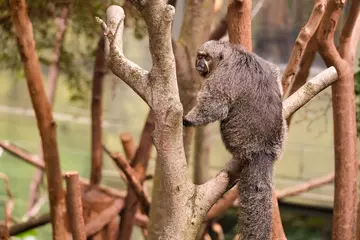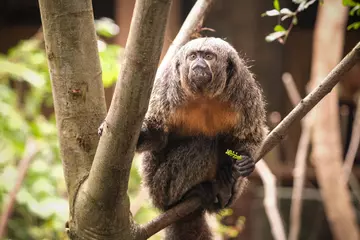Saki monkeys on the move
London’s only living rainforest welcomed a charming family of white-faced saki monkeys this spring.
The family of three – made up of mum Kaituma, dad Milagre and 10-month-old baby Maya – moved to the Regent’s Park conservation zoo from sister-site Whipsnade Zoo on 27 April and have settled in well to their new home in London Zoo’s temperature-controlled tropical biome, Rainforest Life.
The unique-looking primates are, for the first time in their lives, sharing a mixed species habitat where they’ll swing freely with their rainforest neighbours – from tamanduas to a baby two-toed sloth.

Visitors to London Zoo will be quick to notice Milagre’s striking white face. As a species, white-faced saki monkeys display sexual dimorphism, whereby males and females have different visual characteristics, such as colouring or markings. Only male saki monkeys develop bright white fur around their faces, like Milagre.
Monkey keeper Veronica Heldt explained: “The saki monkeys are settling into their new home really well and, after some initial nervousness, have started to interact with the other animals in the walk-through habitat.”
The cheeky trio enjoyed a calm and comfortable journey from Bedfordshire to London after keepers trained them to voluntarily enter their purpose-built travel crates on the promise of a tasty peanut.

“The sakis love sweet potatoes and peppers, so we made sure we had plenty of veg on-hand for their arrival,” Veronica said. “Saki monkeys are great fruit fiends in the wild and have specially adapted incisors and canines to break through tough fruit, seeds and nuts. However, the fruit you or I eat is too sweet for the monkeys, so Milagre, Kaituma and Maya will enjoy a diet of nutritious vegetables and leafy greens instead.”
Saki monkeys (Pithecia pithecia) are native to the tropical rainforests of northern South America and, aside from the male’s distinctive white faces, these sweet-natured animals are known for their long bushy tales. The luscious feather-boa like tales, which can measure up to 16 inches, are the same length as the saki monkey’s body and help them balance as they swing through the rainforest treetops.
Keepers have observed Milagre, Kaituma and Maya’s incredible jumping skilled since their arrival. In fact, saki monkeys have been known to cover leap 10 meters in a single bound when escaping from danger in the wild.

“Little Maya is now 10 months old and is starting to venture away from mum, Kaituma,” Keeper Veronica continued. “Saki monkeys tend to operate in monogamous pairs and small families, so we hope it won’t be long before we hear the pitter-patter of money paws here at London Zoo soon.”
Meanwhile, conservationists from ZSL, the international conservation charity behind London Zoo, continue to study and protect threatened and endangered species across the saki monkey’s native South America – such as the Critically Endangered pygmy three-toed sloth and the Endangered Darwin’s Frog.
Say ‘hi’ to the saki monkey family as well as 15,000 other incredible animals at London Zoo this May half-term. Families can enjoy an action-packed programme of fun at the Zoo’s Spring Family Festival. Book your tickets today:
